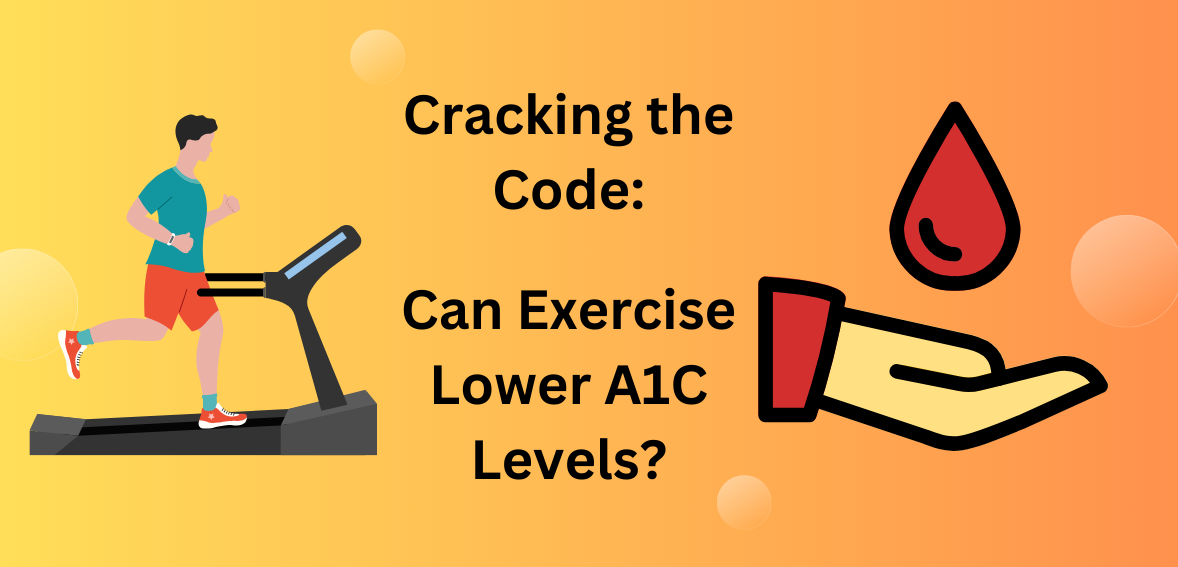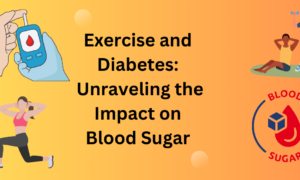Welcome to our blog, where we explore the fascinating world of health and wellness! Today, we’re diving deep into a topic that affects millions of people worldwide: A1C levels. If you or someone you love is dealing with diabetes or prediabetes, understanding and managing these levels is crucial for maintaining good health. And guess what? Exercise could be your secret weapon in lowering your A1C!
In this blog post, we’ll uncover the connection between exercise and A1C levels. We’ll explore different types of exercises that can help effectively lower your A1C, along with some practical tips on how to incorporate exercise into your daily routine. So grab a cup of tea or coffee (or perhaps a bottle of water!) as we embark on this informative journey together.
But before we delve deeper into the impact exercise can have on your A1C levels, let’s quickly go over what exactly A1C is and why it matters so much. After all, knowledge is power when it comes to managing your health!
Understanding A1C levels and its importance
A1C, also known as glycated hemoglobin, is a crucial indicator of your blood sugar levels over the past two to three months. It measures the percentage of hemoglobin molecules that have glucose attached to them. Essentially, it gives you an overall snapshot of how well your body has been managing its blood sugar.
Why is this measurement so important? Well, maintaining healthy A1C levels is key for individuals with diabetes or prediabetes. High A1C levels can indicate poor blood sugar control and increase the risk of complications such as heart disease, kidney problems, nerve damage, and more.
By regularly monitoring your A1C levels, you can gain valuable insights into how well your current treatment plan is working and make necessary adjustments if needed. Your healthcare team will typically set target A1C ranges based on factors like age, overall health condition, and personal goals.
Remember that everyone’s ideal range may differ slightly due to individual circumstances. So it’s essential to work closely with your healthcare professional to establish realistic goals and create a personalized management plan tailored specifically to you.
The impact of exercise on A1C levels
Exercise has a significant impact on A1C levels, making it an important component of managing diabetes. Regular physical activity can help lower A1C levels by increasing insulin sensitivity and improving glucose uptake by the muscles. When we exercise, our muscles use glucose for energy, which helps to regulate blood sugar levels.
Aerobic exercises such as walking, running, cycling, or swimming have been shown to be particularly effective in lowering A1C levels. These activities increase heart rate and breathing rate, helping to burn calories and improve overall fitness. Aim for at least 150 minutes of moderate-intensity aerobic exercise per week or 75 minutes of vigorous-intensity exercise.
Strength training exercises are also beneficial for managing A1C levels. Resistance training helps build muscle mass, which can enhance insulin sensitivity and improve blood sugar control. Incorporate weightlifting or resistance band exercises into your routine two to three times a week.
High-intensity interval training (HIIT) is another option that can be time-efficient while providing excellent results for lowering A1C levels. HIIT involves short bursts of intense activity followed by periods of rest or low-intensity exercise.
Remember to consult with your healthcare professional before starting any new exercise regimen, especially if you have underlying health conditions or complications related to diabetes. They can provide guidance tailored specifically to your needs and help ensure you engage in safe and effective physical activity.
Incorporating regular exercise into your routine alongside healthy eating habits is vital for maintaining a healthy lifestyle and managing your A1C levels effectively over time. Stay motivated and make physical activity a priority – it’s not just about lowering your A1C; it’s about feeling better physically and mentally too!
Types of exercises that can help lower A1C
When it comes to managing your A1C levels, incorporating regular exercise into your routine can make a significant difference. But not all exercises are created equal when it comes to lowering A1C levels. Here are some types of exercises that have been shown to be particularly effective:
1. Aerobic Exercise: Activities like brisk walking, jogging, cycling, swimming, or dancing get your heart pumping and help burn glucose for energy. Aim for at least 150 minutes of moderate-intensity aerobic exercise per week.
2. Strength Training: Building muscle mass through resistance training helps improve insulin sensitivity and lowers blood sugar levels over time. Include exercises such as weightlifting, bodyweight exercises, or using resistance bands into your routine two to three times a week.
3. High-Intensity Interval Training (HIIT): HIIT involves short bursts of intense physical activity followed by brief recovery periods. This type of workout has been found to improve glucose control more effectively than steady-state cardio exercises.
4. Flexibility and Balance Exercises: Yoga and Pilates can help reduce stress while improving flexibility and balance – important aspects in maintaining overall health.
Remember that consistency is key when it comes to reaping the benefits of exercise on A1C levels. It’s crucial to find activities you enjoy so you’re more likely to stick with them long-term!
Tips for incorporating exercise into your routine
1. Start Slowly: If you’re new to exercise or haven’t been active for a while, it’s important to start slowly. Begin with low-impact activities like walking or swimming and gradually increase the intensity as your fitness level improves.
2. Find Activities You Enjoy: To make exercise more enjoyable and sustainable, choose activities that you genuinely enjoy. Whether it’s dancing, cycling, playing tennis, or joining a group fitness class, finding something you love will keep you motivated.
3. Set Realistic Goals: It’s essential to set realistic goals when incorporating exercise into your routine. Be specific about what you want to achieve and break it down into smaller milestones that are achievable within a reasonable timeframe.
4. Make Time for Exercise: Schedule dedicated time in your day for physical activity just like any other appointment or commitment. Treat it as non-negotiable and prioritize your health by making exercise a regular part of your routine.
5. Mix It Up: Variety is key when it comes to staying engaged with exercise. Try different types of workouts such as strength training, cardio exercises, yoga, or pilates to work different muscle groups and prevent boredom.
6. Get an Accountability Partner: Having someone who can hold you accountable can be incredibly helpful in sticking to an exercise routine. This could be a friend, family member, or even hiring a personal trainer who can provide guidance and support along the way.
7. Stay Consistent: Consistency is key when it comes to reaping the benefits of regular exercise on A1C levels and overall health. Aim for at least 150 minutes of moderate-intensity aerobic activity per week spread across several days.
Remember that everyone is unique; find what works best for you in terms of timing, duration, and type of exercise! Regular physical activity combined with other healthy lifestyle choices can have significant positive effects on managing A1C levels. So, lace up your sneakers, find activities you enjoy, and make exercise
Other lifestyle factors that can affect A1C
In addition to exercise, there are several other lifestyle factors that can impact your A1C levels. These factors include diet, stress management, and sleep patterns.
Diet plays a crucial role in managing blood sugar levels. Consuming a balanced diet rich in whole grains, lean protein, fruits, and vegetables can help regulate glucose levels and lower A1C. Avoiding sugary snacks and processed foods is also important for maintaining stable blood sugar.
Stress management is another key component of managing A1C levels. When we’re stressed, our bodies release hormones that can elevate blood sugar levels. Finding healthy ways to cope with stress such as practicing mindfulness techniques or engaging in relaxation exercises like yoga can be beneficial.
Sleep quality and duration also have an impact on blood sugar control. Inadequate or poor-quality sleep has been shown to increase insulin resistance and raise A1C levels. Establishing a regular sleep schedule and creating a relaxing bedtime routine can contribute to better overall glycemic control.
It’s important to remember that everyone’s body responds differently to these lifestyle factors. Consulting with a healthcare professional or diabetes educator will provide personalized guidance on how best to incorporate exercise along with diet modifications, stress reduction techniques, and improved sleep hygiene into your daily routine for optimal A1C management.
So take charge of your health by making mindful choices about what you eat, finding healthy ways to manage stress, and prioritizing restful sleep – all while staying active through regular exercise!
Consulting with a healthcare professional before starting an exercise regimen
Before diving into any new exercise routine, it’s crucial to consult with a healthcare professional. While exercise can have numerous benefits for managing A1C levels, not all types of physical activity may be suitable for everyone.
A healthcare professional will assess your current health status and provide personalized advice based on your specific needs and medical history. They can help determine the best types of exercises that align with your fitness level, potential limitations, and overall goals.
Moreover, consulting with a healthcare professional ensures that you are aware of any precautions or modifications needed to safely engage in physical activity. They can also monitor how exercise impacts your A1C levels over time and make adjustments as necessary.
Remember, everyone is unique when it comes to their health requirements. By seeking guidance from a healthcare professional before starting an exercise regimen, you can ensure that you embark on a safe and effective journey toward lowering your A1C levels.
So take the first step towards better diabetes management by scheduling an appointment to discuss incorporating exercise into your routine! Your healthcare provider will guide you on this path toward improved A1C control while prioritizing your safety and well-being.
Conclusion: Maintaining a healthy lifestyle for better A1C management
Exercise can indeed lower A1C levels and play a crucial role in managing diabetes. By engaging in regular physical activity, you can improve insulin sensitivity, reduce blood sugar levels, and decrease your risk of developing complications associated with high A1C.
Remember that it’s important to understand your current A1C level and consult with a healthcare professional before starting any new exercise regimen. They will be able to provide personalized advice based on your specific health needs and goals.
In addition to exercise, adopting other healthy lifestyle habits such as eating a balanced diet, getting enough sleep, managing stress levels, and taking medications as prescribed can also contribute to better A1C management.
By making these positive changes in your life, you can take control of your diabetes and work towards achieving optimal A1C levels. Start small by incorporating short bursts of physical activity into your daily routine and gradually increase the intensity over time. Remember that consistency is key when it comes to reaping the benefits of exercise on lowering A1C.
So lace up those sneakers or find an activity you enjoy – whether it’s walking, cycling, dancing, or swimming – and get moving! Your body will thank you for it as you strive towards better overall health while keeping those pesky high A1C numbers at bay.

























